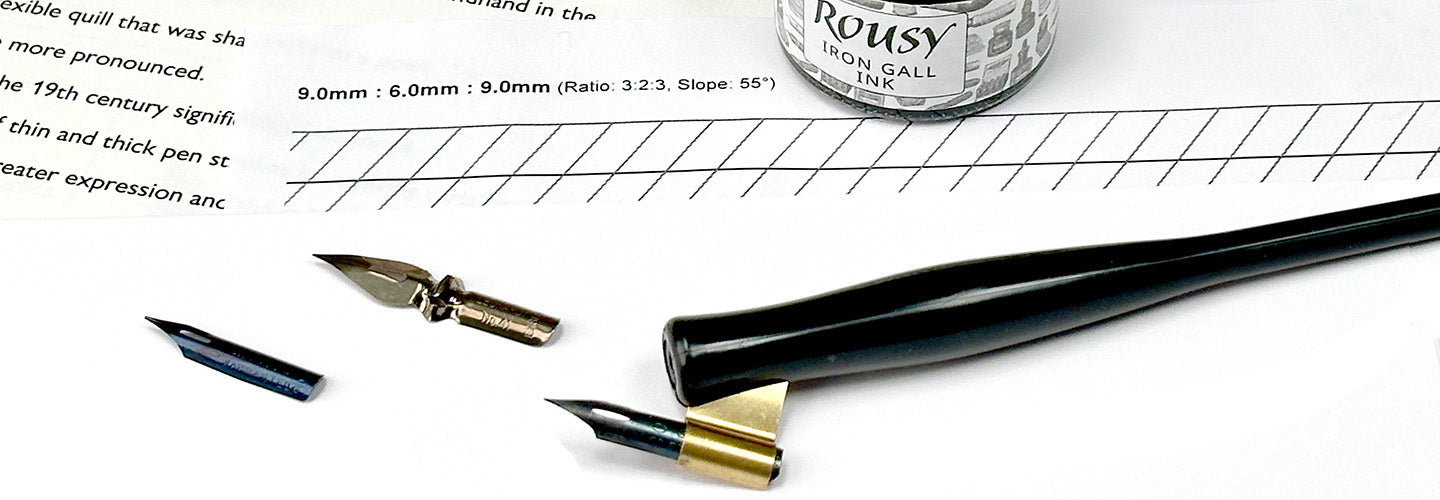
What Skills Do You Need to Be a Calligrapher?
The art of calligraphy is more than just fancy handwriting - it’s a mindful practice that blends technical skill with artistic flair.
Whether you’re a curious beginner or a hobbyist, these skills will help you create gorgeous, expressive writing.
Knowledge of Ink, Tools, and Paper
One of the first things a calligrapher learns is how to choose the right materials.
An understanding of your tools is essential. Traditional tools like broad edge and pointed nib pens, and modern options like brush pens, each have their own quirks.
Likewise, different inks have different characteristics and behave differently on various types of paper and knowing this helps you avoid smudges or bleeding and frustration.
An experienced calligrapher develops a deep understanding of the materials – for example, they know how a particular ink flows on different papers, and the characteristics of a nib to get the desired stroke shape and width. This knowledge helps you pick the perfect combination of pen, ink, and paper for each project.
Artistic Flair and Creativity
Calligraphy is art, so having an artistic eye is a big plus. You don’t need to be Picasso, but a natural flair for creative expression will help your work stand out.
A good calligrapher develops an eye for aesthetics – from understanding different lettering styles and spacing to composing a pleasing layout of words on a page.
It’s about making writing visually beautiful.
With practice, your unique style will emerge. Experiment with flourishes, colours, and layout.
Patience and Persistence
Mastering calligraphy takes patience, time and lots of practice. Those stunning, consistent strokes of other calligraphers you admire are the result of countless hours of careful repetition.
In the beginning, your lines will wobble, and you’ll probably have ink flow problems – that’s okay! Improving in calligraphy is a gradual, even meditative process.
Embracing patience means you won’t get frustrated by early mistakes. Instead, you’ll find joy in slow improvement. Persistence is key: dedicating a little time each day to practice basic strokes and alphabets will steadily build your skill. Remember, each practice session brings you closer to creating the beautiful letters you envision.
Attention to Detail
In calligraphy, the little details make a big difference. That’s why having a keen eye for detail is so important. Calligraphers train themselves to notice subtle nuances – for example, ensuring correct letter proportion and spacing.
This attention to detail is what makes the work look polished and professional. The good news is that your attention to detail will naturally sharpen with practice. Over time, you’ll start spotting the little tweaks that make your lettering more beautiful.
Steady Hand and Control
In calligraphy, having good control over your pen is essential for forming smooth, concise letters.
Calligraphy requires precise hand movements to create graceful strokes and well-formed letters. With practice, you’ll learn how to maintain a consistent pen angle and how much pressure to apply for thick or thin lines, and how to keep your pen strokes consistent.
Think of it like learning a musical instrument: at first your hands might feel clumsy, but with exercises and repetition, the delicate movements become more natural.
Warm up by writing repeated patterns and basic pen strokes.
Conclusion
Being a calligrapher is about more than making fancy letters – it’s about nurturing a combination of skills. You’ll get to know your inks and papers, develop your artistic style, practice patience, and hone your focus and hand control. With time and enthusiasm, anyone can learn these skills.
Gather a pen, some ink, and paper, and enjoy the journey.
